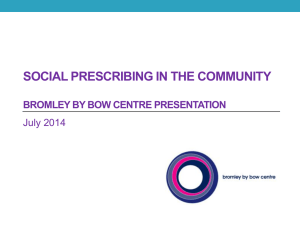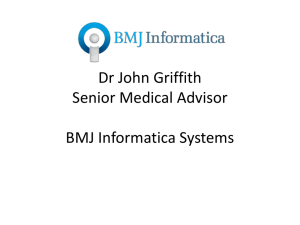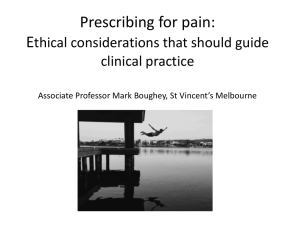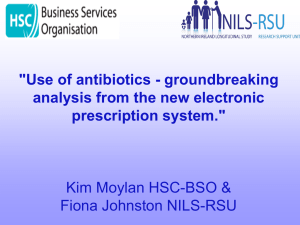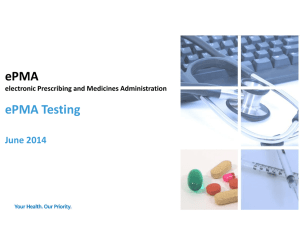125-Hassali-_b
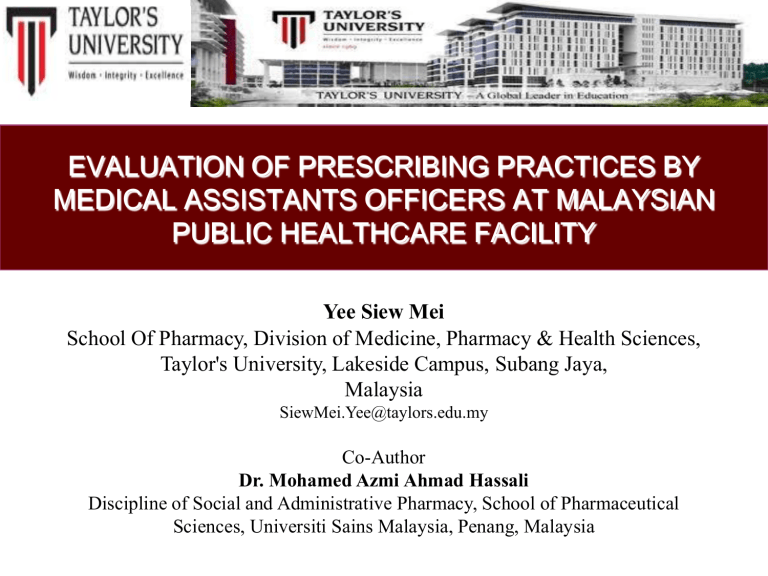
EVALUATION OF PRESCRIBING PRACTICES BY
MEDICAL ASSISTANTS OFFICERS AT MALAYSIAN
PUBLIC HEALTHCARE FACILITY
Yee Siew Mei
School Of Pharmacy, Division of Medicine, Pharmacy & Health Sciences,
Taylor's University, Lakeside Campus, Subang Jaya,
Malaysia
SiewMei.Yee@taylors.edu.my
Co-Author
Dr. Mohamed Azmi Ahmad Hassali
Discipline of Social and Administrative Pharmacy, School of Pharmaceutical
Sciences, Universiti Sains Malaysia, Penang, Malaysia
Medication errors may arise from prescribing, dispensing, drug administration and patient compliance errors. Errors made during prescribing are the most common type of error and it is avoidable.
Dean B. Prescribing errors in hospital inpatient. Qual Saf Health Care. 2002
Prescribing Errors
“A clinically meaningful prescribing error occurs when, as a result of a prescribing decision or prescription writing process, there is an unintentional significant (1) reduction in the probability of treatment being timely and effective or (2) increase in the risk of harm when compared with generally accepted practice”
Dean B. What is a prescribing errors. Qual Saf Health Care. 2002
Prescribers are human and thus make mistake. However, this type of medication mistake is preventable. Medication knowledge deficiency may attribute to prescribing errors. Since these types of medication errors are preventable, therefore it is an important target for improvement.
According to United States Pharmacopeia (USP) on the most recent report examines error trends over the five year period 1999-2003, the percentage of reported errors originating in the prescribing node has steadily increased from 11% (1999) to 23%
(2003). Nearly 80% of the records were associated with the four leading types of errors (omission error, improper dose/quantity, prescribing error, and unauthorized drug).
USP, Drug safety review. Medication error trends for 1999 – 2003
In European, 6.3 – 12.9 % of hospitalised patients have suffered at least one adverse event during their admission and that between 10.8 – 38.7% of these adverse events were caused by medications. 30.3 – 47.0% of these adverse drug events appears to be consequences of medication errors and therefore, maybe considered as preventable.
In United Kingdom hospitals, prescribers make errors in 1.5% of prescriptions; and in primary care errors occur in up to 11% of prescriptions.
Creation of a better medication safety culture in Europe: Building up safe medication practices, 2006
Reference Setting Major Findings
1. Medical Error in
MOH Primary Care
Clinics
Malaysia
12 MOH health care clinics in 4 states
93.4% medical errors preventable
Medication error catered 41.3%
22.6% due to illegible writing
AMOs saw 81% of total records accessed.
Khoo EM et al. Medical errors in MOH primary care clinics KL Institute for Health Systems Research
2008
54% omission error
46% decision error
2. Outpatient
Prescription
Intervention
Activities by
Pharmacists in a
Teaching Hospital
Malaysia Teaching
Hospital
3. Noncompliance
With Prescription
Writing Requirements and Prescribing
Errors in an
Outpatient
Department
Malaysia Teaching
Hospital
Chua SS et al. Outpatient prescription intervention activities by pharmacists. Malaysia J
Pharm. 2003
96.7% omission error
8.4% decision error
Kuan MN et al. Noncompliance with prescription writing requirements and prescribing errors in an outpatient department. Malaysia J Pharm. 2002
Problem Statement
Most study on prescribing errors were carried out at western developed countries such as US and European targeting tertiary health care settings.
In Malaysia there has been 1 study done on medical errors in 12 MOH primary care clinics. Another outpatient prescription intervention study was done in a teaching hospital, but the grade of prescriber was not identified.
There has no study done on prescribing errors made by assistants medical officers (AMOs) in Malaysia primary health care clinics.
AMOs are relied heavily on prescribing and assessing patients in primary health care clinics especially at remote area.
Aim:
to evaluate the prescribing practices by AMOs at a public health setting in Malaysia
Objectives:
to identify the frequency and nature of various types of prescription errors made by medical assistant
to study the prescribing pattern of the medical assistant. to determine whether there is association between prescribing errors with patient’s demographic and disease stage.
Study Design
retrospective study
1 week Rx was collected and evaluated
Inclusion Criteria
Any prescription regardless of diagnosis, duration, numbers of items prescribed, patient’s demography who was receiving treatment at
Kampar Government Health Clinic and Kampar District Hospital.
Prescription that was prescribed by medical assistant from Kampar
Government Health Clinic and Kampar District Hospital .
Exclusion Criteria
Prescription that prescribed by medical officer.
Prescription that was not prescribed by medical assistant from
Kampar Government Health Clinic and Kampar District Hospital.
Data Collection
Omission error
Incomplete prescription
Used of Abbreviation
Illegible Hand Writing
Decision error
Wrong indication
Contraindication
Polypharmacy
Drug interaction
Inappropriate Dosing
Inappropriate duration treatment
Inappropriate dosing frequency
there were 1169 prescriptions were screened and 421 prescriptions met the inclusion criteria
Out of 421 prescriptions being studied, 97% were erroneous.
There were in total 1169 errors found, representing 2.78 errors/prescription
Error rate : 969 erroneous prescriptions with each 1000 new prescriptions generated.
67% : Omission error ; 33% : Decision error
Results
Omission Errors (n=783)
Type of Errors
Inappropriate Abbreviation
Frequency
357
Patient Demographic 3
Illegible Hand Writing
Demographic & Frequency
Demographic, Frequency & Dose
Demographic & Dose
Frequency
Frequency & Dose
Frequency & Duration
Dose & Duration
Duration
3
2
34
1
1
25
352
4
1
Results
Decision Errors (n=386)
Type of Errors
Drug Interaction
Polypharmacy
Wrong Indication
Inappropriate Dosing Frequency
Inappropriate Duration of Treatment
Inappropriate Dosing
Frequency
81
81
76
60
47
39
Contraindication 2
Top 5 prescribed drugs with the highest number of errors
Drug
Infection
Respiatory
GI
Skin
Musculoskeletal and Joint
0 20
121
131
68
40
43
48
60 80
Errors (n)
100 120 140
Discussion
Incomplete Rx
93.1% (n=392) were incomplete with the information required.
According to WHO Guide To Good Prescribing Practical Manual
A Prescription should include:
•
- Name, address, telephone of prescriber
• - Date
•
- Name of the drug, strength
• - Dosage form, total amount
•
- Name, address, age of patient
•
- Signature or prescriber
Absence of patient’s demographic
According to Laurel et al, drug that was contraindicated to patient’s age catered for
8% of prescribing error.
Taylor LK.The challenge and opportunity for patient safety. Healthcare Quarterly. 2005
Patient’s demographic especially the age is crucial although the absence would not prevent the dispensing.
Prescribed in caution for paediatrics and/or geriatric patient.
Absence of drug information
83.6% (n=352) prescriptions with at least one medication which the dose was not noted completely.
Eg: Tab piriton 1/1 tds
Tab PCM 11/11 qid
It may cause problem if the drug available in various strength.
Legibility
•
Assessment is quite subjective and thus may be biased in the study
• Depends on the assessor’s familiarity with the handwriting of the prescriber
Use of Abbreviation
There was 84.8% (n=357) prescriptions with at least one medication was written in abbreviated form.
The nomenclature used for prescribing was found inconsistent and confusing. Terminology varies for individual drugs, within drug classes, or from one manufacturer to another and even based on prescriber’s creativity
Eg: MPC, OMS, MTF, BE, EBB etc
Decision Errors
Accounted for fewer of the prescribing errors than omission errors but more severe adverse effects were associated
Wrong Indication
18% (n=76) of the prescriptions was found at least one item was wrongly indicated
Eg: Antibiotic indicated for viral fever.
Decision Errors
Inappropriate Dosing
Antibiotic overdosing contributes the most.
Greater risk to toxicity and antibiotic resistance due to inappropriate use.
Results
Prescribing errors happened in almost all the patients regardless of their age, ethnicity and gender
Significant association between different disease stages and all the decision errors made was noted (P < 0.001)
Wrong indication with skin disease and infectious disease;
Inappropriate treatment duration and dosing frequency with UTI and endocrine diseases, respectively
Wrong dosing happens more frequent with neonates
Omission errors while dealing with cardiovascular, CNS and endocrine diseases.
Unauthorized prescribing
Malaysian Poisons and Sale of Drugs Act
1952
40% of the prescriptions with at least one item which should only be prescribed by registered medical practitioners.
Limitation
determination of the severity of an error
Severity of the prescribing errors detected could not be justified
data collection was based in Kampar district
Not generalizable
no access to more detailed patient’s data
Other prescribing errors might be undetected.
Conclusion
Prescribing errors are common and without appropriate safety processes such as pharmacist order review in place, present significant risk to patients.
From the study, the prescription errors made by medical assistants were pretty high, accounted for 97% regardless of patient’s age group, gender and ethnicity. But our study found that, the prescribing errors were not the same for different diseases being diagnosed. Around 40% of the prescriptions written by AMOs containing medications that are only authorized to be prescribed by registered medical officers only.
An improvement in health care provider knowledge is needed as practical step to minimize or avoid prescribing errors.
Suggestion for Further Study
It is believed that other districts and states within Malaysia especially health clinic at remote area facing this kind of problem where the AMOs are relied heavily on prescribing and assessing patient.
larger scale study on evaluating medical assistant prescribing errors should be done in order to get a more generalizable data
study to compare types as well as the frequency of prescribing error made by prescribers of other degree should be carried out to get a clearer picture on Malaysia prescribing errors epidemiology
7.
8.
9.
10.
11.
12.
13.
14.
3.
4.
5.
6.
1.
2.
15.
References
National Coordinating Council for Medication Error Reporting and Prevention (NCC MERP) – about medication errors.
NCC MERP Web site. Available at http://www.ncmerp.org/aboutMedErrors.html. Accessed Feb 12,2009 .
S. Nadeem H. Shah, Mohamed Aslam, Avery AF. A survey of prescription errors in general practice. The
Pharmaceutical Journal.
2001; 267: 860-4.
Franklin B Dean, Barber N, Schachter M, C Vincent. Causes of prescribing errors in hospital inpatients: A prospetive study. The Lancet. 2002; 359: 1373-8.
Dean B, Schachter M, C Vincent, Barber N. Prescribing errors in hospital inpatient: Their incidence and clinical significance. Qual Saf Health Care. 2002; 11: 340-4.
Franklin B Dean, Schachter M, Barber N. What is a prescribing errors. Qual Saf Health Care . 2002; 9: 232-7.
Khoo EM, Sararaks S, Lee WK, Liew SM, Azah AS, Rohana I, et al. (2008) Medical errors in MOH primary care clinics.
A project under the letter of intent for improving patient safety. Kuala Lumpur Institute for Health Systems Research
2008.
Stubbs Jean, Haw Camilla, Taylor David. Prescription errors in psychiatry – a multi-centre study. Journal of
Psychopharmacology. 2006; 20: 553-61.
Ridley SA, Booth SA, Thompson CM, The Intensive Care Society’s Working Group on Adverse Incidents. Prescription errors in UK critical care units. Anaesthesia.
2004; 59: 1193-200
Malaysian Poisons Regulations 1952. Regulation 23 (2). Available at http://www.pharmacy.gov.my/html/legistration/Poisons%20195204.pdf
. Accessed Feb 7,2009.
Naing L, Winn T, Rusli BN. Practical issues in calculating the sample size for prevalence studies. Archives of Orofacial
Sciences . 2006; 1: 9-14.
Bobb Anne, Gleason Kristine, Husch Marla, Feinglass Joe, Yarnold Paul R, Noskin Gary A. The epidemiology of prescribing errors: the potential impact of computerized prescriber order entry. Arch Intern Med.
2004; 164: 785-92.
WHO Guide to good prescribing. World Health Organization.
Khaja KAJAI, Sequeira RP, Ai-Ansari TM, Damanhori AHH. Prescription writing skills of residents in a family practice residency programme in Bahrain. Postgraduate Medical Journal.
2008; 84: 198-204.
Minister of Health Malaysia Pharmaceutical Service Division. Amaran penggunaan ubat untuk rawatan “cough and cold” pada kanak-kanak. Pekeliling Pengurusan Farmasi Bil 1/2008. Available at http://www.pharmacy.gov.my
. Accessed Feb
2,2009
Avery Anthony J, Sheih Aziz, Hurwitz Brian, Smeaton Lesley, Chen Yen Fu Howard Rachel, et al. Safer medicines management in primary care. British Journal of General Practice. 2002;(Suppl):S17-S21.
20.
21.
22.
23.
24.
16.
17.
18.
19.
25.
26.
27.
28.
29.
30.
31.
References
Joint Formulary Committee. British national formulary. 56th ed. London: British Medical Association and Royal
Pharmaceutical Society Of Great Britian; 2008.
Franklin B Dean. Leaning from prescribing errors. Qual Saf Health Care.
2002; 11: 258-60.
Batty R Barber N. Ward pharmacy: a foundation for prescribing audit. Quality in Health Care.
1992; 1: 5-9.
Meyer Tricia A. Improving the quality of the order – writing process for inpatient orders and outpatient prescriptions. Am
J Health-Syst Pharm.
2000; 57; Suppl 4; S18 – S22.
Franklin B Dean. Leaning from prescribing errors. Qual Saf Health Care.
2002; 11: 258-60.
Institute of Medicine. To Err is Human. Building a Safer Health System.
Washington, DC: National Academy Press;
1999.
Institute of Medicine of National Academies. Preveting medication errors: the quality chasm series. Available at http://www.iom.edu/Object.File/Master/35/943/medication%20errors%20new.pdf
. Accessed April 23,2009.
United State Pharmacopeia. Drug safety review. Medication error trends for 1999 – 2003. Available at www.usp.org
.
Accessed April 23,2009.
Expert Group on Safe Medication Practices. Creation of a better medication safety culture in Europe: Building up safe medication practices. Council of Europe 2006.
Barber N, Rawlins M, Franklin B Dean. Reducing prescribing error: competence, control and culture Qual Saf Health
Care . 2003; 12: Suppl 1; i29 – i32.
Taylor LK, Kawasumi Yuko, Bartlett G, Tamblyn R. Inappropriate prescribing practices: The challenge and opportunity for patient safety. Healthcare Quarterly. 2005; 8: 81 – 5.
Zermansky AG. Who controls repeats. British Journal of General Practice. 1996; 46: 643 – 7.
Lesar TS. Prescribing errors involving medication dosage forms. Jorn Gen Intern Med . 2002; 17: 579-87.
Bergk V, Gasse C, Rothenbacher D, Leow M, Brenner H, Haefeli WE. Pharmacoepidemiology and drug utilization.
Drug interactions in primary care: Impact of a new algorithm on risk determination. Clinical Pharmacology. 2004; 85 –
96.
Veehof LJG, Stewart RE, Haaijer-Ruskamp FM, Meyboom-de Jong B. The development of polypharmacy. A longitudinal study. Oxford University Press . 2000; 17 (No3): 261 – 7.
Ghaleb MA, Barber N, Franklin B Dean, Wong ICK. What constitutes a prescribing error in paediatrics. Qual Saf Health
Care . 2005; 14: 352 – 7.
Acknowledgement
Dr. Mohamed Azmi Ahmad Hassali (Supervisor)
Dr. Asrul Akmal Shafie (Co-Supervisor)
Dr. Zuraidah Mohd. Yusoff (Co-ordinator) and all M. Pharm lecturers
Dr. Junaidi B. Ibrahim (Peg. Kesihatan Daerah Kinta)
Dr. Suraya Bt Amir Husin (Peg. Perubatan Pentadbir KK Kampar)
Dr. Malek Sazali B Abdul Razak (Ketua Pengarah Hospital Kampar)
My family, fellow friends, colleagues
